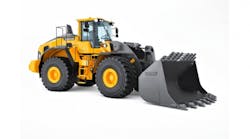Today, in this difficult rental environment, many large rental companies have switched their focus to positive cash flow. I always operated under the premise that a healthy rental company produces negative cash flow, and that in difficult rental times a rental company produces positive cash flow. In good times, rental companies buy a lot of equipment and expand their fleet; in tough times, rental companies minimize their fleet purchases or, in extreme situations, defleet.
The end result of not replenishing rental equipment for any company in our business is increased fleet age. So how old can a rental fleet be and still operate effectively?
When I operated a rental company, the lowest average fleet age I operated with was 18 months. Now we are seeing the large rental companies planning to age their fleets to an average age of 33 to 42 months.
When I first came to the business in the early '80s, I began a strategy of purging the older equipment from the fleet and offering new state of the art equipment. At that time, the industry standard was a fleet age of about 72 months. I had a significant competitive advantage in offering a younger fleet than my competitors. My strategy was: buy a lot, sell a lot and keep the customer happy.
Buy a lot
The more equipment a company purchases, the lower the acquisition price becomes. So when a company sells off a significant portion of its fleet yearly in order to decrease or maintain fleet age, it has to increase the purchases for replacement fleet, and hence buy a lot of equipment.
Sell a lot
I always say that if you are in the rental business, then you are in the equipment sales business. In order to maintain fleet age, a rental company must sell off a portion of its older fleet on an annual basis.
Selling used equipment is a business unto itself and is, if the fleet is properly depreciated, a profitable business. So the more you sell, the more money you can make. This strategy has worked extremely well up until the year 2001. In 2001, we began seeing an abundance of late model equipment searching for a buyer. Nevertheless, a properly depreciated fleet can still be sold for a profit even in today's environment. Now, in the second quarter of 2002, there are positive indications that prices for used equipment are on the rebound.
Keep the customer happy
Nothing keeps a customer happier than a late model, properly operating piece of rental equipment. Back in the 80s, when we at Hertz were offering nearly new equipment with a young fleet age, vs. the competition with much older fleet, guess what happened? The competition followed, sold off their older fleet, and dramatically lowered the age of their fleet.
The issue today is the quality of the rental product offering is very consistent as the chart indicates below.
A recent survey of rental customers by Merrill Lynch indicated 74 percent considered the condition of the rental equipment they were using to be good. Twenty percent considered it excellent, 6 percent rated it fair and nobody said it was poor. That indicated that for the most part, rental equipment is consistently offered in good to excellent condition and that a very young fleet is no longer a major competitive advantage, since almost all rental companies are offering good to excellent quality equipment.
How old should it be?
As long as I have been in the rental business, the age old question remains: “When is the proper time to replace one's fleet?” Or said another way: “How old can a rental fleet be and still be cost effective?” The answer depends on the following factors.
- The competitive environment: If your competitors maintain the same strategy, and age their fleets, then there is not a competitive reason to lower average fleet age.
- Provided the return on capital investment (ROI) remains acceptable and your company can overcome the following operational and financial considerations:
Maintenance cost
Maintenance cost must be kept in check. Maintenance cost as a percentage of rental revenue usually runs between 9 percent and 14 percent. As the fleet ages, maintenance cost as a percentage of rental revenue will increase. These increases can be dramatic with older equipment as major components fail. If maintenance cost as a percent of rental revenue reaches the mid to high teens, fleet replacement may be necessary.
Warranty expiration
The rental industry purchased a tremendous amount of equipment between 1997 and 2000. The warranty of this equipment is expired or expiring. Warranty is a direct correlation to maintenance cost. Warranty recovery has the effect of lowering maintenance cost by 2 percent for a company operating a young fleet.
Customers' acceptance
The rental customer has been trained to expect late model, excellent condition equipment. There is a point that the customer will demand equipment with a young fleet age. This is especially true for large rental companies whose customers are the large national accounts. I have often seen clauses in these national account contracts defining what an acceptable fleet age is.
Equipment replacement cost
Equipment replacement cost is a positive in today's competitive environment. Up to a year or so ago, new equipment costs were escalating 3 to 5 percent per year. I believe it is possible to buy the same piece of equipment you purchased one or two years ago, at the same price today. Manufacturers have experienced difficulty in obtaining proper prices for their offerings.
Used equipment sales price
The most important factor in maintaining a young fleet is the ability to sell the older equipment at a profit or at a minimum break-even. This has been difficult the past two years. Used equipment sales have diminished, fleet age has increased. A lot of construction equipment is being sold through trade packages rather than retail sales.
As I stated earlier, there are positive indications that the price for used equipment is on the rebound. Retail sales prices are increasing and prices being realized in equipment auctions are also improving.
Capacity to repair equipment
Most rental companies operate their branches under a preventive maintenance mode. By that I mean they can do routine simple repairs at their facilities. They do not have the capacity to carry out major repairs such as transmission and large engine overhauls. This type of repair was not necessary when operating a young fleet but will become necessary as the fleets age.
The cost of these types of repairs can well exceed $10,000 — a problem that few large rental companies have experienced with their younger fleets.
Mechanics staffing
For a rental company operating under a preventive maintenance mode, mechanic staffing normally ranges between one mechanic to $900,000 to one mechanic to $1.3 million of equipment, first cost. With older fleets, this ratio will not work. More mechanics must be hired and trained.
Machine uptime
I recommend that a well-managed rental company operate at a fleet efficiency of 97 to 98 percent. That means that 97 to 98 percent of the fleet is available for rent. As the fleet ages, the fleet will be down more time for repairs. Downtime or loss of the equipment for rent is a cost that must be understood in determining the proper fleet age for your company.
Depreciation schedule
Depreciation has a direct relationship to fleet age. If the fleet is not depreciated properly, one will experience a loss at time of disposal. We have seen a couple of public rental companies recently take a large hit to their financials as they made an adjustment to their book values in order to dispose of excess rental equipment. An improper depreciation schedule will make it difficult if not impossible to dispose of fleet.
Ability to finance
In today's environment, many rental companies have been experiencing difficulty in obtaining favorable financing for their equipment. This is especially true for the smaller rental companies, which include the typical American Rental Association members. If you can't finance it, you can't buy it; if you can't buy it, your fleet will age.
Conclusion
I believe that the correct strategy for a rental company is to offer the customer equipment with a relatively young fleet age. I am recommending a fleet age of between 26 and 36 months; the lower the better. Realize that when your fleet has an average age of between 26 and 36 months, the older fleet in your company is four to six years old. What is right for your company will vary depending on your interpretation of the factors listed above.
It is safe to say that to make this critical evaluation, rental software is required to help in a ROI analysis. But in the end, the customer will help you to decide.
Daniel Kaplan is CEO of Daniel Kaplan Associates, Morristown, N.J. He is the former CEO of Hertz Equipment Rental Corp. and now works as a consultant to the rental industry. He can be reached at (973) 285-3199; or [email protected].


